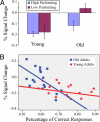Age-related memory impairment associated with loss of parietal deactivation but preserved hippocampal activation
- PMID: 18238903
- PMCID: PMC2538895
- DOI: 10.1073/pnas.0706818105
Age-related memory impairment associated with loss of parietal deactivation but preserved hippocampal activation
Abstract
The neural underpinnings of age-related memory impairment remain to be fully elucidated. Using a subsequent memory face-name functional MRI (fMRI) paradigm, young and old adults showed a similar magnitude and extent of hippocampal activation during successful associative encoding. Young adults demonstrated greater deactivation (task-induced decrease in BOLD signal) in medial parietal regions during successful compared with failed encoding, whereas old adults as a group did not demonstrate a differential pattern of deactivation between trial types. The failure of deactivation was particularly evident in old adults who performed poorly on the memory task. These low-performing old adults demonstrated greater hippocampal and prefrontal activation to achieve successful encoding trials, possibly as a compensatory response. Findings suggest that successful encoding requires the coordination of neural activity in hippocampal, prefrontal, and parietal regions, and that age-related memory impairment may be primarily related to a loss of deactivation in medial parietal regions.
Conflict of interest statement
The authors declare no conflict of interest.
Figures



References
Publication types
MeSH terms
Grants and funding
LinkOut - more resources
Full Text Sources
Medical
Molecular Biology Databases

